Does the dominance of this Benevento in Serie B side lend itself to survival in the big time next season or does the style and way this dominance has been achieved make them an easy target again for every opponent next season?
The Sorcerers were promoted back to Serie A last month after a dominant season in Serie B. It is the second spell in the top flight in three seasons, their first time in their history in 2017 will be remembered as they set a record for the worst start to a season in any of Europe’s top five leagues by losing their first 14 Serie A matches. This streak famously ended with a 95th minute equalising header from goalkeeper Alberto Brignoli for a 2–2 home draw against A.C. Milan. They were relegated after a last-place finish having won only six of their last 23 games.
Statistical Overview
We will consider the relegated teams in Serie A and see how Benevento compare to these sides. While it will be difficult to say where they could have finished in comparison it should provide some context. This is because, two of those sides, Brescia and Lecce were promoted into Serie A after finishing first and second the season before. Their dominance hasn’t translated into survival.
First up, their xPoint number is 64.6 for the thirty-eight game season. That total would still have placed them second in Serie B behind Crotone’s 68. However, they finished the campaign with eighty-six points a full 7 wins and a draw in front of that expected total.
In Possession
- Benevento average 1.76 goals per game. A third of chances created on average end in goals. We will look into this outstanding conversion rate later.
- From an xG standpoint, the figure per game stands at 1.53. Benevento perform slightly above where they should be according to the amount of goals they have scored.
The bottom three in Serie A struggled in front of goal. Lecce, who scored sixty-six in their promotion season did the best with forty-nine goals at 1.28 per game.
Their xG of 53.1 was accurate in output and gave them an expected goals of 1.39 per game. Benevento are not too far in front of that figure and that could be concerning for Inzaghi. As we will see, the simple nature of the way Benevento attack has its obvious positives but if teams can deal with the threats posed then Benevento could find it difficult to find the back of the net.
Out of Possession
Benevento are somewhat unremarkable with the ball outside of the final third but their defensive organisation and the numbers around this side of the game are compared to the rest of Serie B and those relegated teams in Serie A are very strong.
Here are some examples.
Before lockdown and the stoppage of football, Benevento had conceded fifteen goals in twenty-eight games. Teams averaged 0.53 goals per game against Benevento from just three chances given up per game. That goal count jumped to twenty-seven at the season conclusion, an overall goals conceded per game of 0.71.
Brescia and Lecce conceded forty-two and forty-six in their promotion seasons, while Verona, also promoted that season conceded forty-eight that same year. For Benevento to survive, they will need to find some of Verona’s stats next season. Lecce scored more than Verona’s forty-seven goals this season but were undone by conceding eighty-one in return, just over two per game.
Verona conceded 1.26 goals per game, the same record as third-placed Atalanta and only bettered by the teams in the top four. This is an area that Benevento can be as successful in and could be one area that Inzaghi’s can control his team’s destiny.
While these are comparative stats, what makes them amazing stats in themselves is that as a collective, Benevento are nowhere near league leaders in statistical categories you would expect to find them leading given their position and record. Only one Benevento player features in any of the top ten tables. Striker, Massimo Coda sits in 8th place in aerial duels contested. That’s it, no players in shots blocked, challenges, recoveries, interceptions, shots blocked and successful tackles.
One of the few stats they find themselves in the top three for is least shots conceded in 90 minutes. The figure of 9.90 is a little higher than expected for a team conceding so few goals but the average shot distance is 21 yards from goal and carries an xG average of just 0.08. In comparison, Lecce and Brescia conceded the most shots from the shortest distance in Serie A. The only teams to have an average shot distance from inside the box when you are allowing that to happen around sixteen times per game, it will catch up with you.
Benevento make only 8.58 or 12% of their recoveries on average each game in the opponent third of the pitch, it isn’t the lowest in the league but it sits comfortably in the bottom half of the league. For Serie B context around this stat, Juve Stabia, who began after lockdown in 13th place and 30 points adrift of Benevento make only 7 recoveries on average in the opponent third and sit last on the table for shots conceded at 13.64 per game. Their 68 goals conceded is a huge contributing factor in their final finishing position of 19th and relegation from Serie B.
Benevento are adrift at bottom of the league for passes per defensive action (PPDA). They give up 10.45 passes per defensive action which is well below the league average of 8.9.
In Serie A it is a tale of two teams. Lecce who concede the most shots from the shortest distance allow 14.16 PPDA across their season and as a result struggle to stop teams from attacking their goal. They will be changing places with Inzaghi’s men, while Verona sit third behind Atalanta with 8.61 PPDA.
Tactical Overview
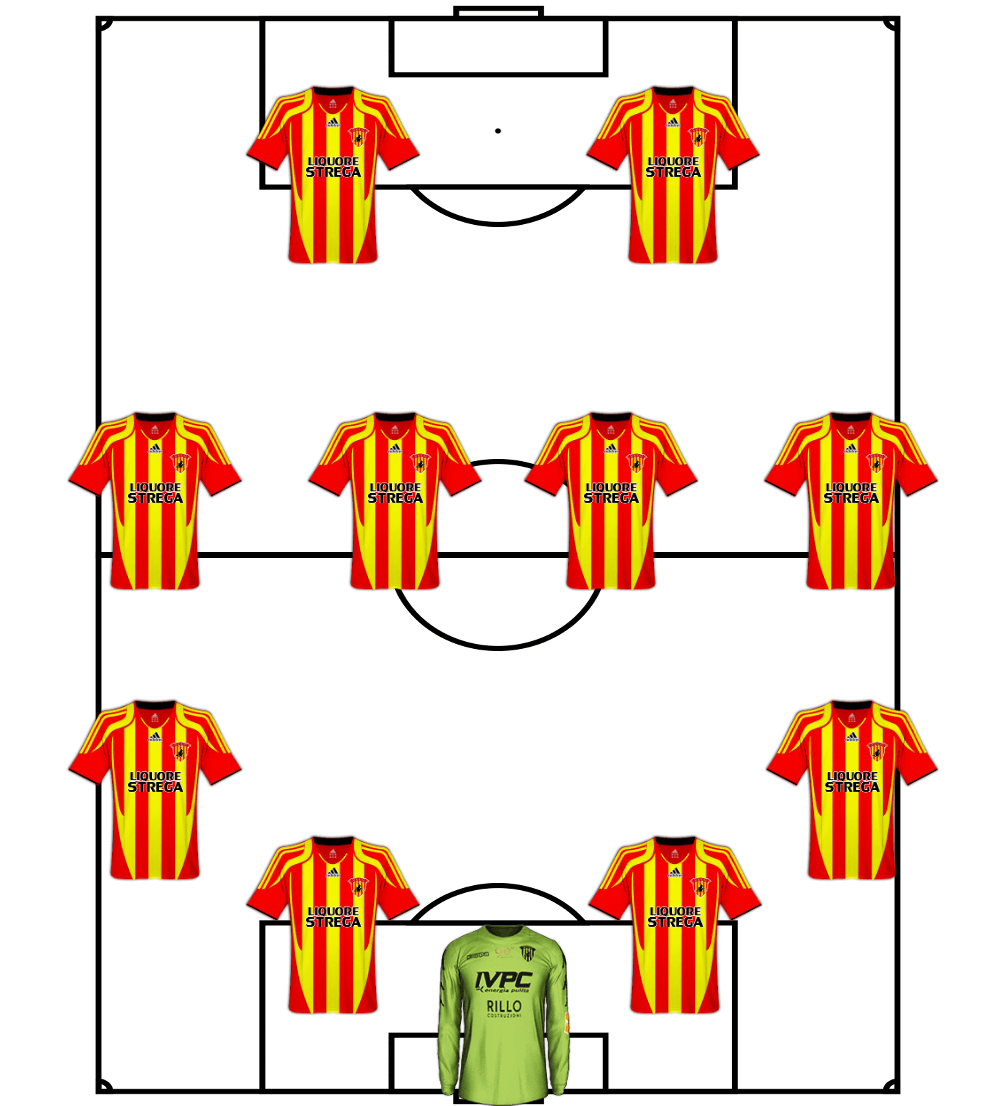
The standard 4-4-2 system has been used by Inzaghi for most of the season. They flick into 4-3-3 in some games but it has been normal to find the system on show each week.
Christian Maggio and Gaetano Letizia have been almost ever-present on each side of the back four while captain Luca Caldirolta has played in every game to date at centre back. Nicholas Viola and Pasquale Schiattarella have anchored the midfield together for the second half of the season while Roberto Insigne has been a key contributor from right midfield. Massimo Coda has led the line in every game so far and has been a huge part of the attacking threat Benevento pose from crosses into the box. Continuity has been key for them. Players like Perparim Hetemaj have made key contributions throughout the season in central midfield, mostly from the bench.
The Benevento playing model through the thirds
How can Benevento be so far ahead of the pack based on their defensive foundation when they are just an average individual defending team statistically?
What can they do better defensively to help them manage the step into Serie A and be Verona and not Brescia?
As a headline statement, Inzaghi’s men can be described by the following statement.
“A methodical and incisive approach to creating and scoring built around attacking across the pitch with numbers in advanced positions to dominate transitional moments. Underpinned by a superior defensive organisation to defend their goal and limit time and space in dangerous areas.”
In a snapshot, with the ball they take few risks in deeper areas, preferring to play front half football, they get numbers into the penalty area at both ends and take advantage of unstructured moments when possible.
This analysis will look more deeply at their defensive organisation and how they can transfer their structures into Serie A and also look at how dangerous they are when they can get the ball into the opposition penalty area.
How they are compact
If teams create moments of good possession, a lower block is deployed by Benevento with a big emphasis on staying compact between the lines and across the pitch.
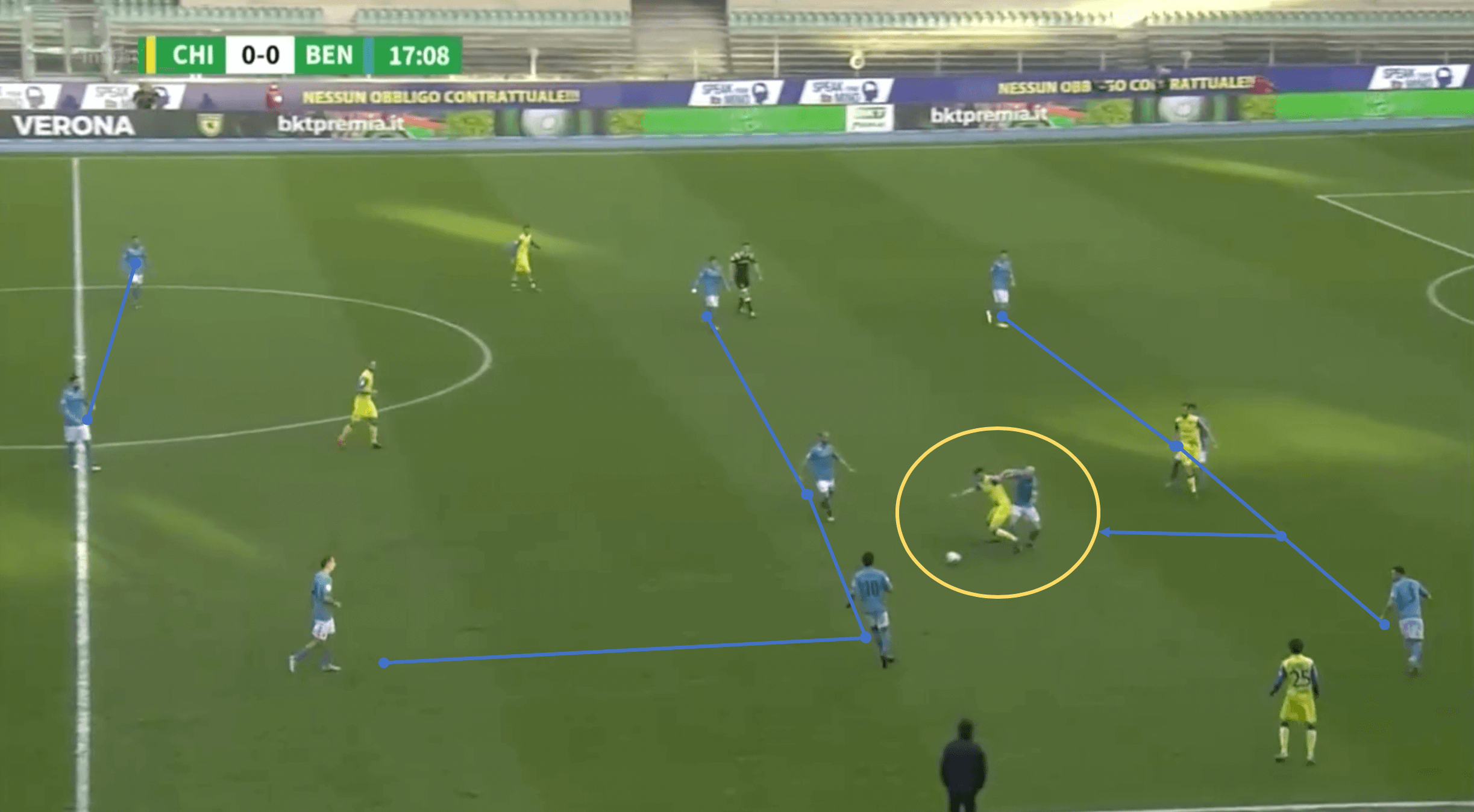
In this image, having six players in this section of the pitch allows a more zonal defensive system to take the lead while the players react to balls played into their zone. As we can see, it makes it nearly impossible for the opponent to progress the ball in these moments and creates plenty of opportunities for Benevento to recover the ball themselves.
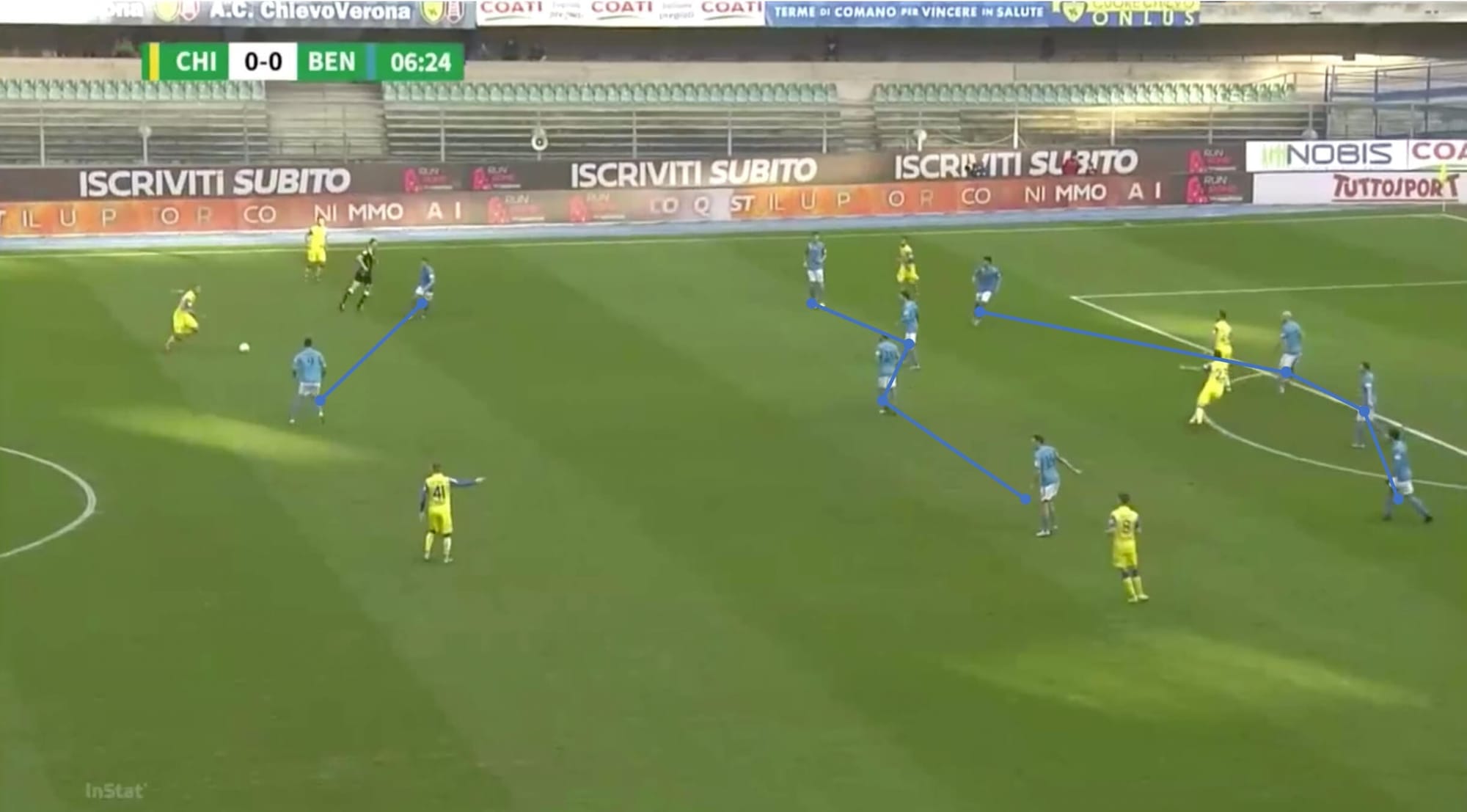
Rather than engaging the ball with their full-back, Benevento drop deeper and delay. This gives time for the wide midfielder and even the striker on that side to get across and deal with the ball. As the image shows, now we have all of the team defending together in three lines. The position of the two central midfield players in relation to the ball here is vital to protect the ball into the feet of the opponent front two. This structure allows them to limit creativity but also deal with longer passes with ease with now little space in behind.
This type of defensive structure will help them in Serie A but they will only be as successful as the amount of shots they concede around the box and how comfortable they are with teams like Napoli and Atalanta creating overload moments in wide areas and breaking into the box rather than crossing into the area like many teams in Serie B. The double layer block will be hard to break through, especially if they can limit the switching opportunities for their opponents however if they can’t, their defensive midfield duo will find it difficult to cover the spaces and protect their back four and therefore open up opportunities for 1v1 moments in and around their box, with the increased quality in the final third in. Serie A, this could cause Inzaghi real issues during the season.
How they defend the goal
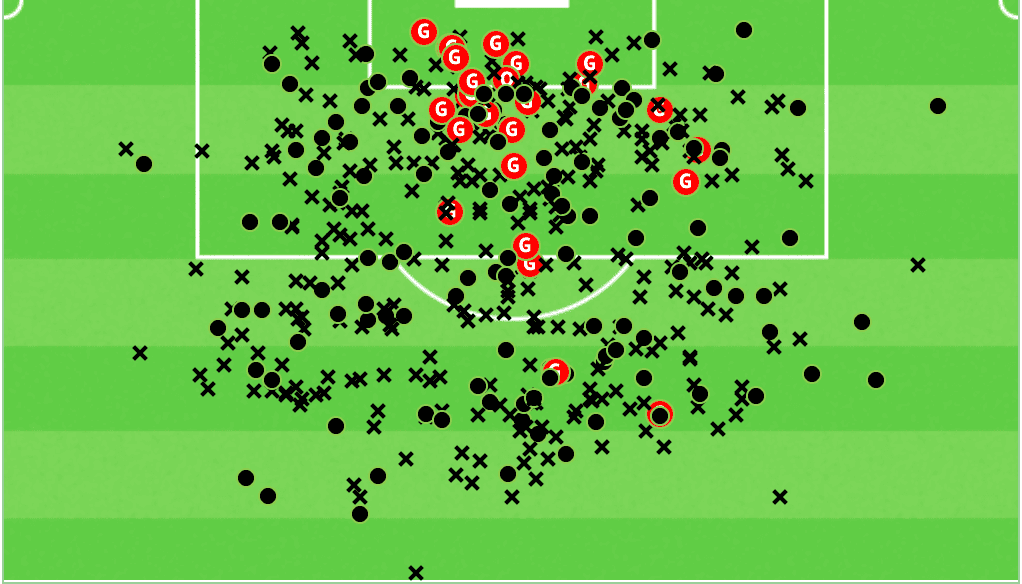
The number of shots from deeper change the average distance of those shots to the higher end as mentioned earlier but the real insight here is that 229, or almost exactly half of those shots, have been taken from inside the box. 86 of those shots were on target for the 25 goals conceded inside the box. A little over two shots a game on target from inside the box would lend itself to the thought that they should concede more goals but, only three penalties carry an xG of over 0.6 and more remarkably only eight have an xG over 0.4. A shot every four games from inside the penalty area with an xG of over 0.4 is an incredible statistic and possibly the biggest indicator of why Benevento concede so few goals.
The more players they get around the ball is the key. It limits time and space, producing shots from minimal touches thus lowering the chance of quality. A large chunk of these chances will likely be reaction-type efforts that could come from messy moments of play and therefore instinctive, again reducing their quality.
For the higher end chances like this example below there is a big difference and this will be one area that Inzaghi will need to limit if Benevento are to prevent goals being scored.
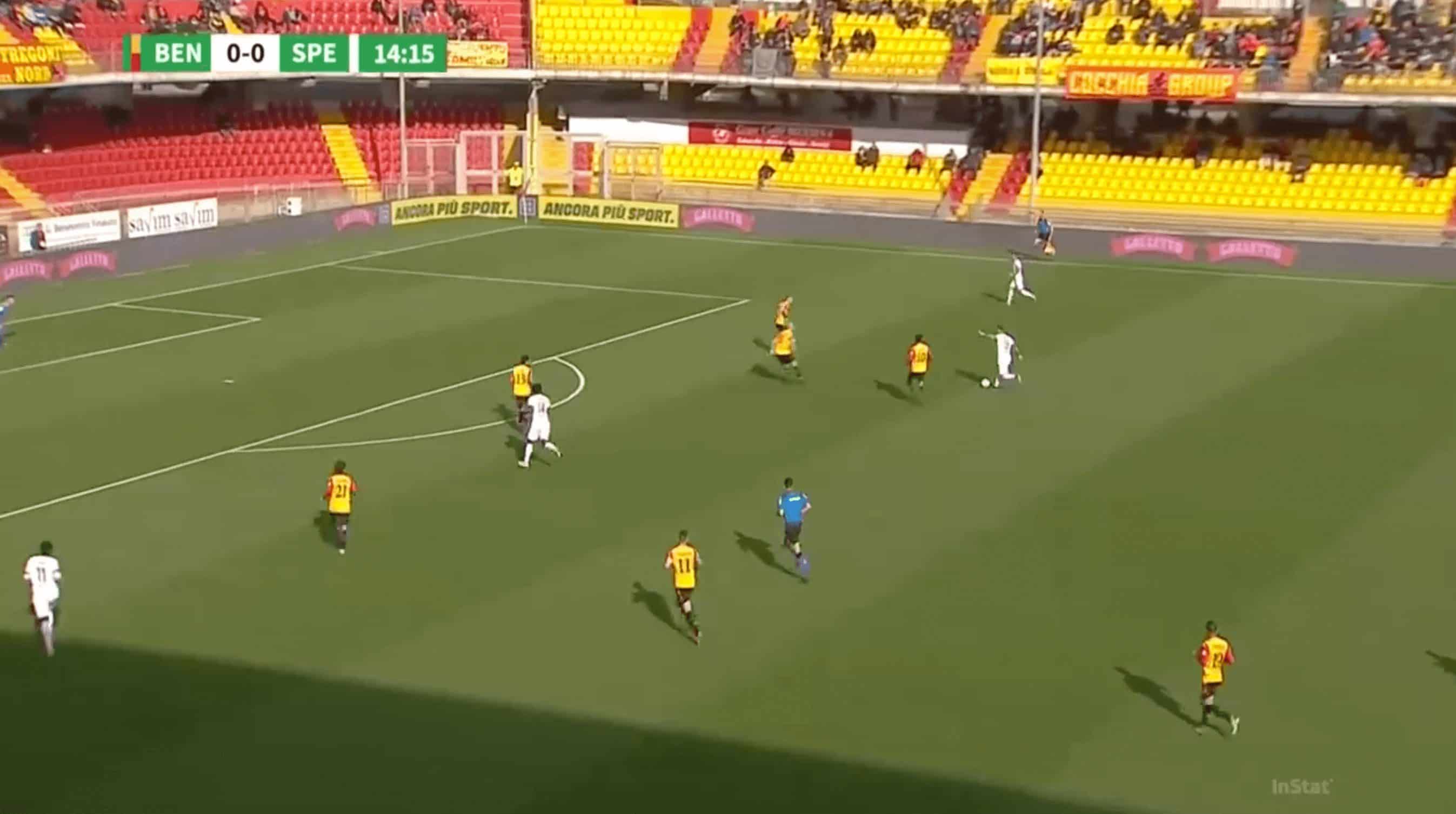
In this image, the Benevento centre-back steps out of the line to deal with a potential shot on target. Leaving the line with the fullback already engaged creates a rare moment where they are without an overload in their line.
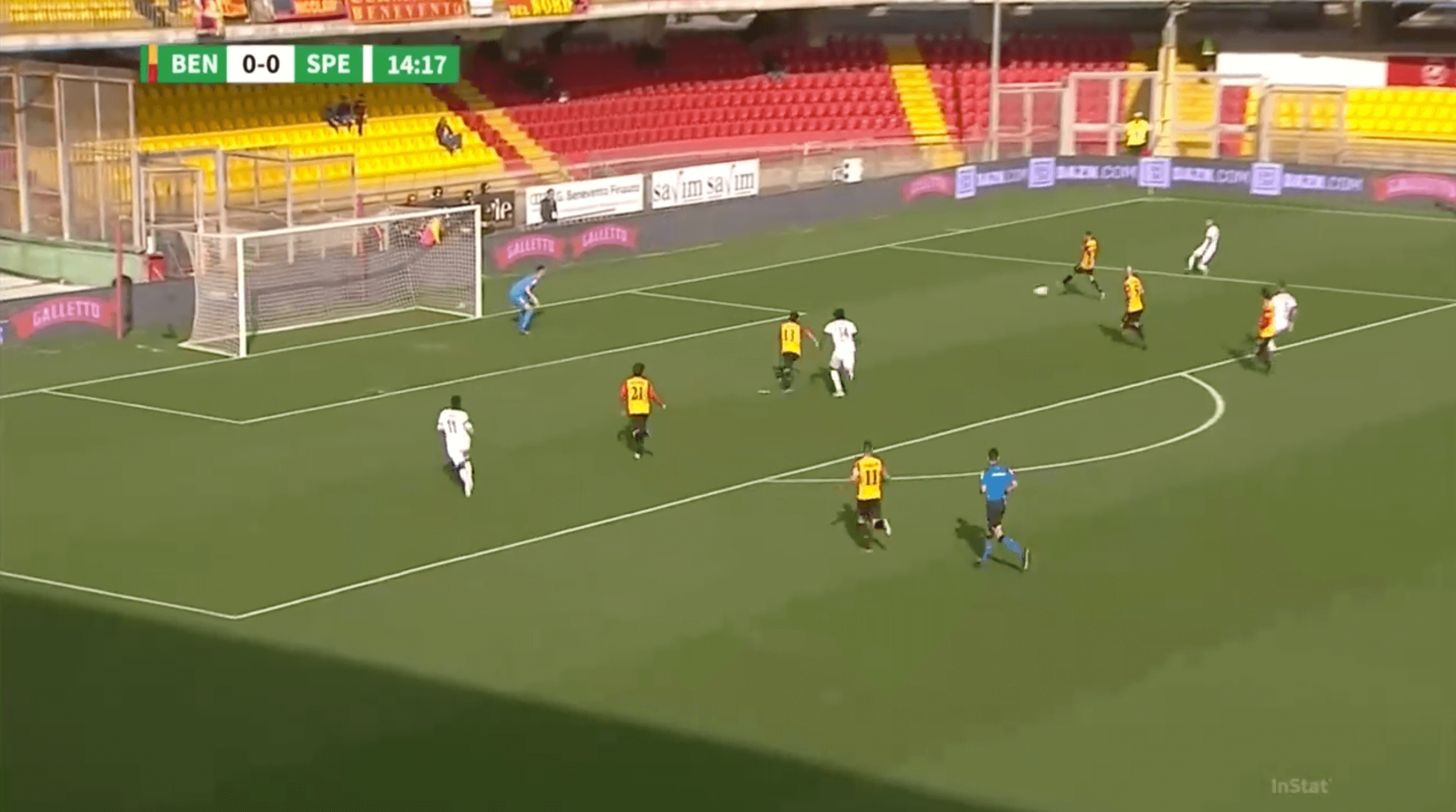
Two issues, first, there is now a real lack of numbers in the box. The second is the body shape of the backline. Facing their own goal is Benevento’s biggest weakness if it can be exploited. Balls in behind the backline for crosses delivered in between the goal and the recovering defenders. These account for 5 of the 8 chances with xG higher than 0.4 (the other three are penalties) from within the penalty area.
This sort of chance has been few and far between however, in Serie A they will be exposed more and more to these situations. The more Inzaghi can limit these moments the more chance they will have of being Verona not Brescia.
How they create and score
Benevento are not a team that will pass opponents of the pitch. Their pass count in Serie B is exactly mid-table with 368 passes per game on average. Just over a third of these are forward in direction with just on 15% of those total passes tagged as long passes. While they don’t claim to be dominant with the ball, they are efficient and work hard to get the ball into the right areas to create and score chances as we will see. In comparison, in Serie A Verona’s passing stats are almost identical to Benevento, they average one pass more and play forwards on average only once more than Benevento during matches. Inzaghi should be looking to this example rather than the one set by Brescia who are bottom of the pile with just over 300 passes per match.
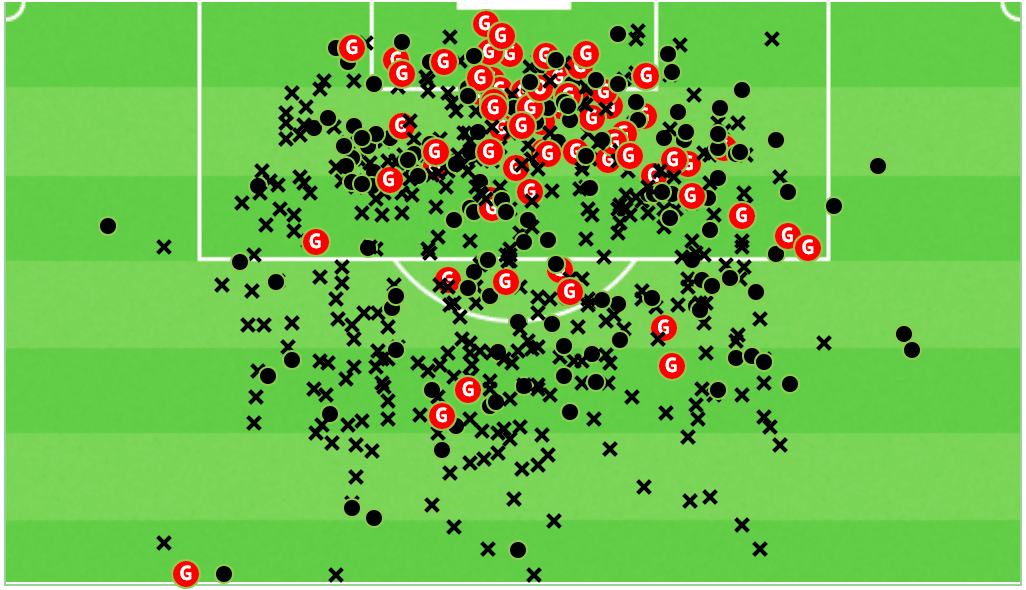
This is a graphic of every shot that Benevento had in Serie B, all 572 of them. What is striking straight away is the density of those shots taken and scored from within the confines of the penalty area. The efforts on target, the vast majority of those efforts come from crosses into the box from wide areas.
“That lad must have been born offside”. Sir Alex Ferguson is so famously quoted as saying in relation to Inzaghi’s capabilities as an unconventional forward. If ever a team was created in the image of their leader, Benevento would be right up there with the big names right now, the ruthless efficiency they create and score with is hard to match.
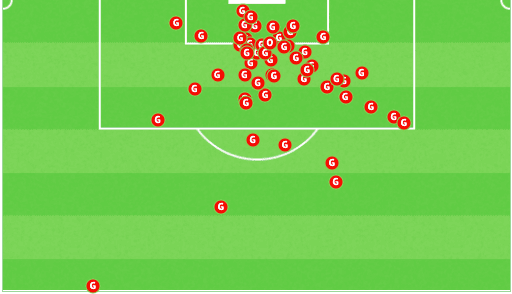
This is an overview of all the goals scored. Fifty-four goals scored this season have come from within the width of the goal, no further than 15 yards from goal.
If you buy enough tickets to the raffle you can win, but it’s always better to stack the odds in your favour.
It took 232 shots with 110 shots on target from within this area to produce those fifty-four goals. Just a tick under one in two goals from shots on target which is a gold standard mark for chances created in the top five leagues. What makes that even more remarkable is that only four of those chances were deemed to carry an xG of 0.6, these chances had a 75% conversion rate. It is also clear that Inzaghi as a player and the team he currently coaches are one and the same in terms of style.
There are three major themes for these chances. Crossing, Incisive play to forward runs and set pieces. This analysis like look closely at the crossing theme.
Crossing
Thirty-four goals from a cross. 58% of goals this season have their origins from a ball delivered from wide areas either deep to the far post, where the majority of chances were from second balls or cutbacks to finishes from runners from the second or third lines.
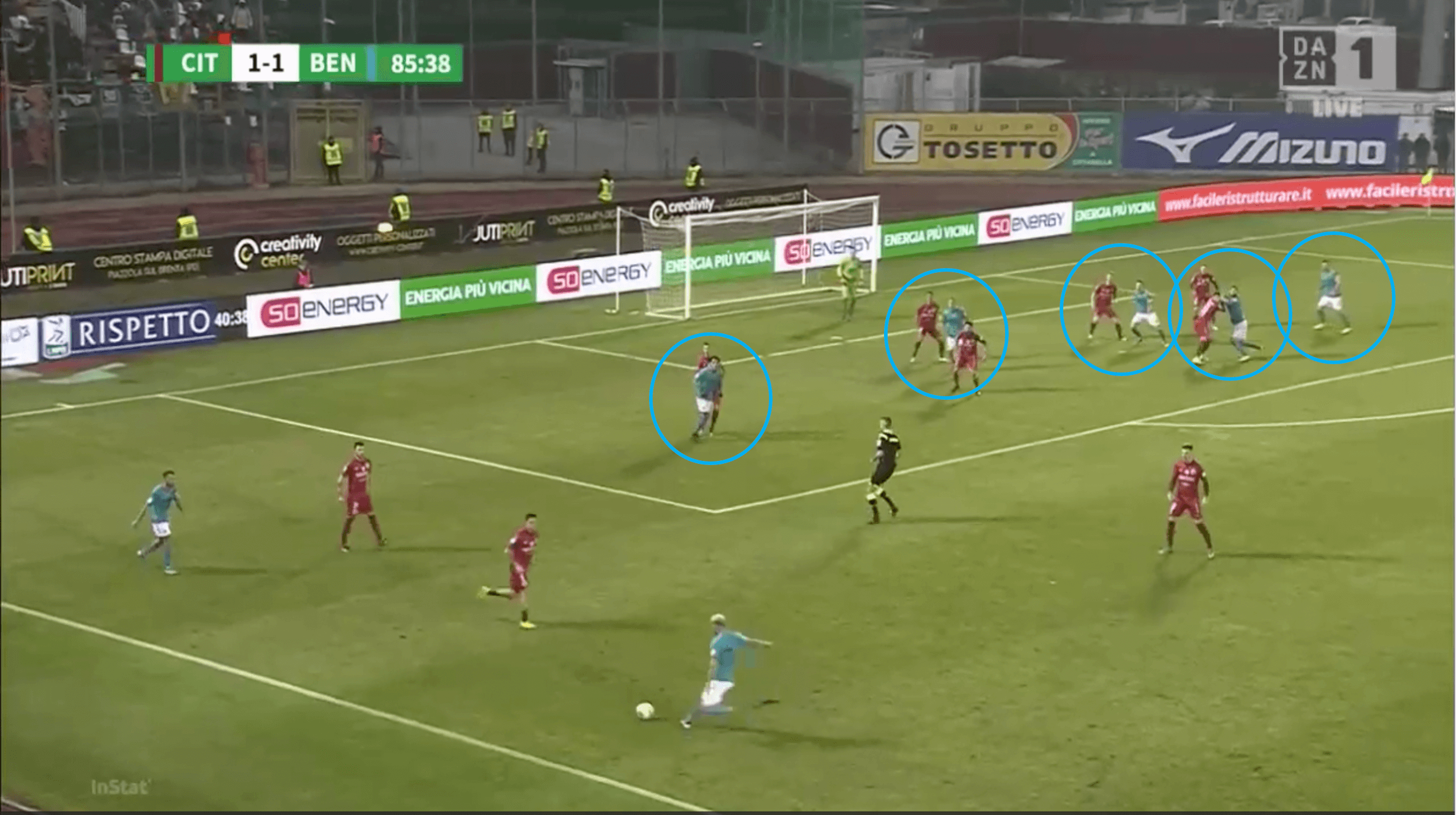
This image shows a scenario played out over 200 times throughout the season. There is a real commitment to load numbers into the box in anticipation of balls delivered from these areas. Once it is on its way there is a real trend that the first contact is made by the runners from the second or third lines. The highest line, usually the front players are responsible for knockdowns, poor clearances and outright mistakes to pounce on and score. There is an obvious emphasis on tap-ins from following up at the goalkeeper too.
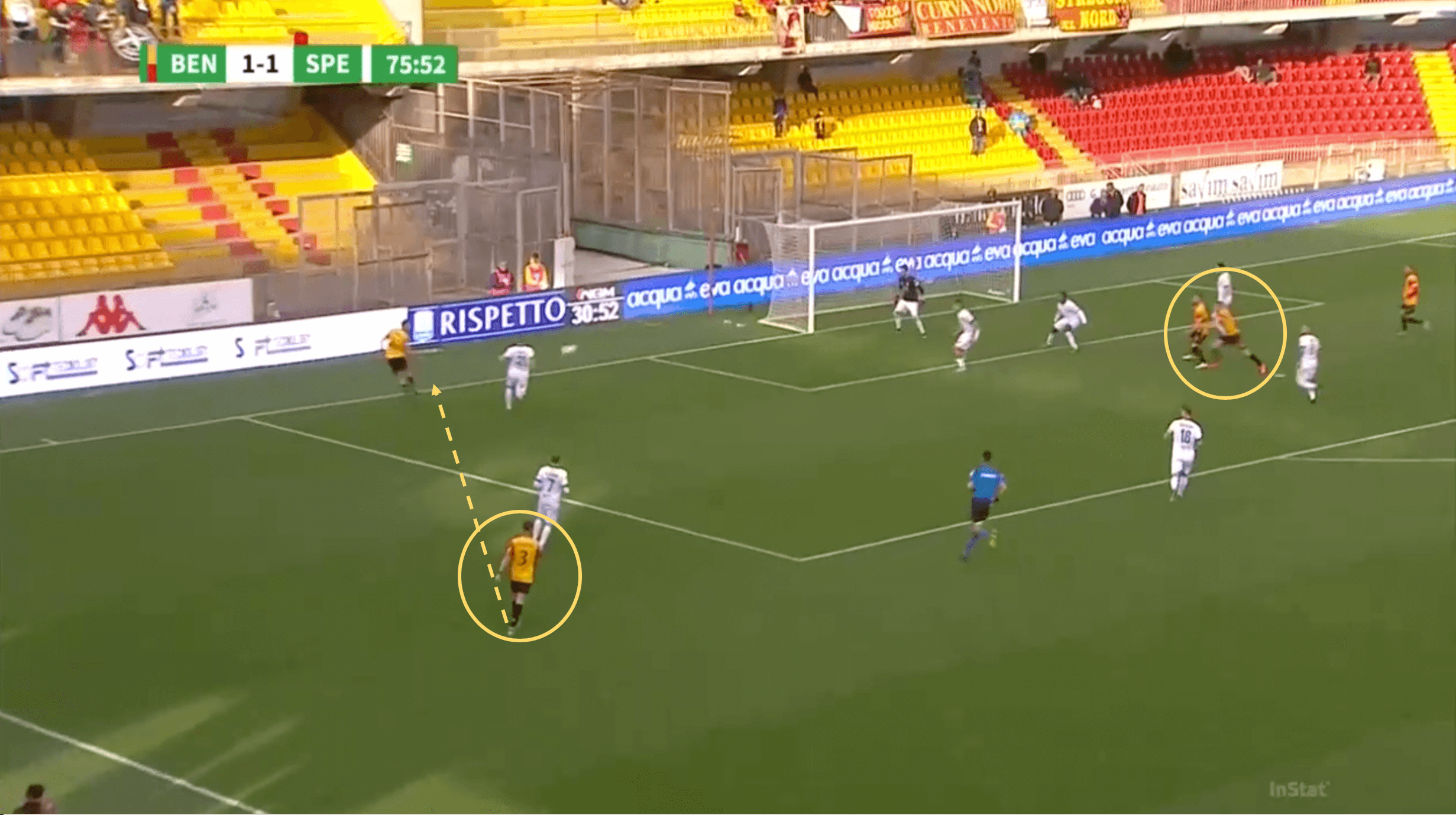
The second variation of crossing style can be seen here. The constant delivery into the box from this same position allows Benevento to create a secondary chance like this one. Notice the two runners circled in the box, who are within the width of the goal again. The deeper of the two runners, in the second line scores the goal.
Can they survive and thrive in Serie A?
At times of possession Benevento show themselves to be more than capable of dominating possession in order to carve out chances.
Once the ball gets into the box, either from incisive fullback passes into forward runs from the pocket or from deeper crossing positions, this is when Benevento show their true qualities. Ruthlessness in front of goal is the major difference between them and everyone else in Serie B. The number of players they get into the right areas and the efficiency they get the ball into these areas is really something. The desire to pick up rebounds and mistakes is linked so heavily into Inzaghi’s style it is strikingly obvious that it is a major part of their weekly work.
The overview of Benevento’s defensive foundation can be summed up by the phrase “the sum of the parts is greater” When they are organised, they control the opponent and what the can do to progress the ball. It is a mostly zonal system with everyone filling their role within each line. Everyone contributes and there is obvious pride in what they do without the ball. They know what they are good at and they stick to it as much as they can. This does not mean they do not suffer at times and they are happy to concede possession.
As individuals, only Alessandro Tuia has a challenge success rate of over 70% which tells the story that the collective effort is far greater than individual quality and therefore when they are prepared and controlling the opponent it is very difficult to get success.
It will be interesting to see if they can limit those future opponents so effectively to keep their head above water in the big time. If they can add a little more quality to the group with those new faces buying into Inzaghi’s obvious tactical foundations they could be difficult to take points from. Whether they are to everyone’s liking will be up for debate but the objective facts of football will never change. Two teams of eleven players try to prevent and score goals to win games.
Are they enjoyable to watch? At times, when the opportunity arises for sure. They are not for everyone, but you cannot help but admire their commitment to the process and their desire to implement the playing style the manager has put in place for them. That alone will help them in their quest to survive the big-time next season. If they can use a Verona blueprint they can survive. Can they thrive? One step at a time, the lessons learnt by all concerned on the last ill-fated effort will also help them build towards long term Serie A sustainability.





Comments